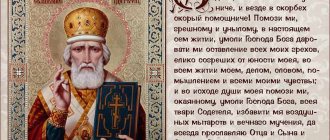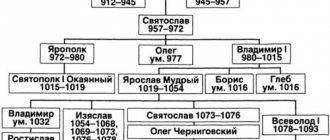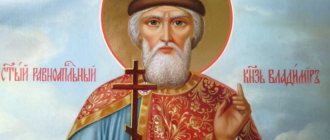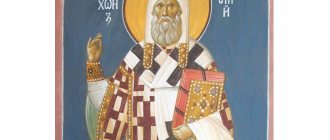The Orthodox faith has been a faithful companion of Slavic wives for many centuries. But their meekness, devotion and wisdom towards their husbands, children and people were dictated not only by their personal qualities, but, above all, by their deep faith in our Creator. It was thanks to faith that the well-being of the inhabitants was ensured, churches and monasteries were built, and lands were conquered. For their services to people and our Lord, many of the outstanding women were canonized.
Their path was not filled with roses. But they did not ask for much, they responded to any call for help, worked hard, supported all those suffering and prayed. Deep faith in Our Lord was their main companion. Defending their faith, they suffered, were tortured, starved and doomed to many other sufferings. But prayer, as well as the voice of God, supported them in the most difficult moments and gave them strength.
Our Creator generously rewarded them; they could see the future, feel the pain of others and heal. Many of them had a strong character and could lead entire nations. Their voice was heard far away, because in the name of the Lord they did good deeds. That is why people still remember them, despite the fact that many centuries have passed since the date of death of some.
Matrona of Moscow:
Matrona was born in the Tula province into a peasant family. The girl was blind from birth, and her parents thought of abandoning her. But in a dream, the mother saw a blind bird of extraordinary beauty. This dream was regarded as prophetic, and the child was left behind.
From the age of 8, Matrona was a fierce believer, possessed the gift of healing and predicted the future. At the age of 18, the girl’s legs gave out. Matrona moved to Moscow in 1925. Matrona devoted most of her life to helping all those who suffer. During the day she received people, gave them advice, healed them, and at night she prayed persistently.
Blessed Matrona died in 1952. She was canonized in 1999 as a locally revered saint of the Moscow diocese.
Nowadays, people pray to Saint Matronushka for any troubles and misfortunes, as she bequeathed during her lifetime. People regularly visit the monastery, where the relics of the saint are located. Previously, queues of pilgrims lined up at Matrona’s grave.
A carved wooden icon of this saint can be purchased here.
Duchess Olga
Photo: Krestilnoe.ru
The life of women in the 10th century in Russia was not easy. They had no opinions and were subordinate to men, mostly traders and warriors. There was no great power yet, individual volosts were separated and were united only by trade interests, a common language and customs of the Varangians.
But Olga was beautiful and intelligent, and also endowed with many talents, such as wisdom, patience, mercy, chastity and diplomacy. The Lord generously rewarded her, because she was assigned a very important role - to become the progenitor of Christianity in Rus'. And her religious procession began.
In 903 she became the wife of Prince Igor. Thanks to her intelligence, as well as patience and beauty, she soon became not only his beloved wife, but also the prince’s adviser, taking 2nd place in the political hierarchy. During long military campaigns, Prince Olga single-handedly ruled the country and was very successful, the people loved her.
20 years later, Igor died in another skirmish with the Drevlyans; Olga found solace in the Christian faith. Soon after the death of her beloved husband, she was baptized in Byzantium and became the beloved sister of Basileus. Her faith was so deep that she carried it throughout Rus', visiting all major cities and towns.
But Olga understood that the Russians would not convert to the Christian faith overnight, so she not only talked about God, but also redistributed the tribute, evenly distributing the funds received among the suffering. Her mercy knew no bounds, she provided help to everyone who needed it, and she retained this attitude towards people until the end of her life.
At her command, monasteries and temples began to be built in Rus', which led to the spread of Christian teaching. Her son Svyatoslav did not understand his mother’s aspirations, so he refused to change his faith, but Olga’s holy work was completed by her grandson Vladimir, who, one might say, continued the mission begun by Olga after her death in 969.
After 25 years, her grandson Vladimir retrieved Olga’s relics, which remained incorrupt, and solemnly placed them in the Church of the Tithes. The flow of sufferers to her relics was endless, and many received healing. In 1547, Olga was canonized by the Orthodox Church, moreover, she became the first woman recognized as an Equal-to-the-Apostles saint. After all, she managed the almost impossible, to create a great and strong power, uniting the scattered Varangians and turning her people away from paganism, giving them faith in Christianity.
Evdokia Dmitrievna:
Evdokia was born into the family of Prince Suzdal in 1353. The girl got married at the age of 15. Her husband was the famous Prince Dmitry Donskoy. The happy family life lasted 22 years. After the death of her husband, Evdokia held the reins of government in her hands. She organized the construction of many temples and monasteries.
In 1407, Evdokia went to the Ascension Monastery, lived very little and died in the same year. In 1988, Evdokia and her husband were recognized as saints.
Outstanding Women of the Church: Grace and Courage
The Lord celebrates His ascetics with miracles and gifts that would glorify any of the men - clergy or monks. We decided to recall the exploits of several famous holy women. Of course, there have been thousands of times more of them in history, but only the Lord knows everyone. Miriam , a prophetess, the sister of Moses and Aaron, proclaimed a song of praise to the Lord after Pharaoh’s army drowned in the Red Sea: “Sing to the Lord, for He is highly exalted...” (Ex. 16:20-21). This song became the first hymn of thanksgiving in Christian hymnography. But when the prophetess began to reproach Moses for taking an Ethiopian wife as his wife, the Lord descended in a pillar of cloud and punished Miriam for “exceeding authority” and interfering in matters other than his own with leprosy. She was forgiven only through the intercession of Moses. Deborah is a prophetess who was a judge of Israel (judges were the rulers of the Jewish people from the death of Joshua until the accession of the first king Saul. Judges performed not only administrative functions, but were also spiritual mentors). According to her prediction, the people of Israel defeated the army of the Canaanite king Jabin, who enslaved God’s chosen people. During her further reign, “the earth rested for 40 years” (Judg. 4, 4-14; 5, 1-12). Mary Magdalene - this saint is called “the apostle of the apostles” because the risen Savior was the first to appear to her, and she told His disciples about this (see John 20: 1-18). The name of Mary Magdalene is associated with the tradition of dyeing eggs for Easter - the saint had an argument with Emperor Tiberius: he argued that it was more likely that the chicken egg that she wanted to present to the emperor could turn red than that Christ could rise from the dead. Then the egg in Mary's hand turned red.
Left: The appearance of the risen Christ to Mary Magdalene. Right: Rogier van der Weyden. Reading Mary Magdalene Thebe is one of the first deaconesses in the history of the Church. The Apostle Paul wrote about her: “...a helper to many and to myself” (Rom. 16:1). Priscilla is a martyr, the wife of the Apostle Aquila (see Acts 18:2-3; Rom. 16:3-4). The Apostle mentions her and her husband as the first Christian teachers of faith, “who laid down their lives for my soul, to whom not only I thank, but also all the churches of the pagans.” Hieromartyr Justina suffered for Christ in the 3rd century along with her former tormentor and tempter Cyprian. He, being a sorcerer and magician, turned to Christ, seeing the faith of Justina. St. Justina is one of many martyrs who, by their own example, converted their persecutors to Christianity. Saint Nina , Equal to the Apostles, converted the Georgian people, led by the king, to Christianity in the 3rd century. She went to this service at a young age at the behest of the Mother of God, who, admonishing Nina, handed her a cross made of grapevines. St. Nina converted militant pagans to Christianity and is known for many miracles. Discovered the location of the Lord's robe. Holy Martyr Julitta was burned at the stake in 304 (or 305), refusing to renounce her faith. In a conversation in memory of the martyr Julitta, St. Basil the Great, setting her up as an example to Christians, exclaims: “Do not allow, husbands, that you turn out to be worse than wives in piety!” Venerable Syncletikia is the founder of the female monastic tradition; she, seeking an opportunity to devote herself to God, after the death of her parents, distributed all their property to the poor and with her blind sister retired to a tomb that belonged to her relatives (IV century). After the place of her solitude was accidentally discovered, women began to flock here, also seeking heroism. The venerable woman wrote instructions to monastic women; she became one of the three ammas, whose statements are given in the Ancient Patericon (the patericon contains the sayings of 117 holy fathers). Deaconess Olympias is a devoted disciple of St. John Chrysostom. In 405, she was thrown into prison on false charges, the saint consoled her in letters that have reached us: “Your treasure that you have collected is inviolable, and the dignity created by these sufferings knows no change and does not expect an end.”
Elena Cherkasova.
“Letters to Olympias” Venerable Macrina lived in the 6th century. She was engaged to a pious young man, but after he died before the wedding, she chose the virgin life. By her example, she attracted her own mother Emilia to the monastic path. The younger brothers Macrina, the holy teachers of the Church Basil the Great and Gregory of Nyssa, called her their teacher, citing the fact that she knew the Holy Scriptures better than them. The Venerable Mary of Egypt - after repenting of her sins, she went into the desert beyond the Jordan and lived there for forty-seven years in complete solitude without shelter, clothing, and almost without food (VI century). Her life is a monastic ideal, an example of deep spiritual transformation. A special penitential service during Lent - “Standing of Mary of Egypt” - is dedicated to the memory of her feat. Venerable Cassia lived in the 9th century in Byzantium. The only woman whose works are still used in worship to this day. The author of the main part of the canon of Great Saturday “By the Wave of the Sea”, the stichera of Great Wednesday “Lord, even the wife who fell into many sins, who felt Your Divinity...”, the stichera for the Nativity of Christ “To Augustus, the sole ruler of the earth...”. In total, 2 canons and 49 troparia are attributed to her, as well as spiritual poems and wise sayings. One of them reads: “I hate silence when it’s time to talk.” One day Cassia paid dearly for her boldness in speaking out. Emperor Theophilus, who was choosing a bride for himself, at a show where the most beautiful and noble maidens were gathered, was struck by the beauty of Cassia and, deciding to test her, asked: “Did the evil happen through the wife?” She answered: “But the best begins through the wife.” The emperor decided that she was too smart and did not marry her. True, according to another version, Cassia specifically objected to the emperor so that he would reject her, since she did not want to become the wife of an iconoclast emperor. The Byzantine church historian Nikephoros Callistus Xanthopulus included her name in a rhymed list of famous hymnographer poets, along with St. Theodore the Studite, St. Kosma Mayumsky and Andrei Kritsky. After the emperor refused to marry her, Cassia founded a monastery in Constantinople, which was admired by her contemporaries. It is believed that the letters written by St. Theodore Studit to a certain maiden Cassia, were addressed specifically to the nun-hymnographer. The monk writes: “Both wise and reasonable is everything that your virtue again told us; Therefore, we were rightfully surprised and thanked the Lord when we met such intelligence in a young girl.” Cassia the hymnographer is glorified by the Greek Orthodox Church as a saint. The Holy Equal-to-the-Apostles Princess Olga - after the death of her husband, Prince Igor (in 945), began to rule the principality, in her life we read: “Princess Olga ruled the regions of the Russian land under her control not as a woman, but as a strong and reasonable husband.” One of the first on Russian soil to convert to Christianity. Grandmother of Saint Prince Vladimir, who baptized Rus'.
Before her baptism, Olga was a very stern ruler. On the illustration: Revenge of Princess Olga. Miniature from the Radziwill Chronicle The Holy Blessed Princess Fevronia is the pious daughter of a simple peasant beekeeper; she impressed the Murom prince Peter with her prudence and resourcefulness and became him a worthy wife. The Murom boyars feared the intelligence and insight of the princess and more than once made attempts to quarrel between the spouses and “replace” Fevronia, citing her low origin. But Fevronia, with patience, humility and wise behavior, maintained peace in the family and defeated the boyars’ machinations. The couple died on the same day and hour in 1228, having previously taken monastic vows. Holy Blessed Princess Anna Kashinskaya - wife of St. blgv. Prince Mikhail Yaroslavich Tverskoy. Her husband, two sons and grandson were killed by the Tatars in the Horde. The saint, who bravely endured the blows of fate, ended her life in the monastery in 1338. “In your feminine nature you had the strength of a man...” - this is how the Church blesses Saint Anna Kashinskaya for her spiritual fortitude. This is the only saint in the history of the Russian Church who was decanonized during the schism with the Old Believers by decree of Patriarch Joachim in 1677, prohibiting the veneration of her holy relics. (The Old Believers considered her their patroness.) But in 1908, Anna Kashinskaya was again canonized. St. Righteous Juliana Lazarevskaya, the Merciful , is a Russian saint of the late 16th century, glorified as a pious laywoman for her service to others. Having married the owner of the village of Lazarevskoye, the saint devoted the daytime to prayer and caring for her family—Iuliania gave birth to ten sons and three daughters—and at night she did needlework. She sold her works and used the proceeds to help those in need. When famine came, she fed the starving people in secret from her relatives. After the death of her beloved and revered husband, the saint distributed the family property to the poor. During the even more terrible famine of 1601-1603, when it came to cannibalism, Juliana baked bread from quinoa and tree bark to feed people. But even in these difficult years, as her son writes, “she was neither saddened, nor embarrassed, nor complained, but was more cheerful than the first years.” Blessed Ksenia of St. Petersburg - after the sudden death of her husband, she decided to repent for the fact that he died without confession, accepted the most difficult feat of foolishness: renouncing home, family, all worldly goods, in fact fulfilled the commandment of Christ, becoming “poor in spirit.” She wandered around the city, lived on alms, and secretly performed good deeds. She was revered in St. Petersburg as a saint during her lifetime. She died around 1803. Canonized in 1988. Venerable Martyr Elizabeth -
Left: Grand Duchess Elizaveta Feodorovna. Right: the remains of Elizaveta Feodorovna, raised by the White Guards from the Alapaevskaya mine, Grand Duchess, widow of Grand Duke Sergei Alexandrovich (brother of Alexander III). Raised in a Protestant family, after marriage, seeing the faith of her husband, after many prayers and reflections, despite the protests of her relatives, she consciously and heartily accepted Orthodoxy. After the murder of her husband by terrorists, she left secular life and founded the Martha and Mary Convent of Mercy - a fundamentally new form of serving others in Russia, combining prayer and activity. Organized a wide service to help the sick, orphans, and disabled people. She herself went around the brothels, collecting abandoned children for her shelter. She refused to leave Russia after the revolution. She was arrested in 1918. Among other martyrs, she was thrown into a mine near the city of Alapaevsk, where, despite her own suffering, she helped the wounded until the last hour. Martyr Tatiana (Grimblit) -
resident of Tomsk. When exiles began to arrive in Siberia in the 1920s, Tatyana donated almost all her funds for food and belongings and donated them to the prisoners. Among them were bishops and priests. In 1923, she was arrested on charges of helping exiled clergy, corresponding with them, and conducting “religious conversations.” To these accusations, Tatyana replied: “I have never hidden my faith,” “You can spend your money on wine, clothes, a sweet piece, but I prefer to dress more modestly, eat more simply, and send the remaining money to those in need,” “The cross has been given.” forever, it can only be removed from me with my head.” She was shot on September 23, 1937 in Butovo. Blessed Matrona of Moscow was blind from birth, and from the age of ten she could not walk due to illness. She was honored with a visit from the Mother of God and with her prayers helped in various needs to everyone who turned to her for help. They walked towards her in a continuous stream. She was arrested by the Soviet authorities for the fact that, as written in the protocol, “with her holiness she greatly influences the dark masses.” She died in 1952. One of the most revered recently glorified saints. Venerable Maria Gatchina (Lelyanova) (1874-1932) -
the last of the female saints canonized by the Russian Orthodox Church, she was canonized on July 17 of this year.
Born into a wealthy merchant family in St. Petersburg. She managed to graduate from high school, then fell ill with encephalitis and was paralyzed for 20 years. Despite her illness, she consoled believers during the years of persecution of the Church, giving them spiritual advice. With the blessing of sschmch. Veniamin, Metropolitan of Petrograd, took monastic vows in 1922 with the name Maria. In response to one person’s complaint about painful and hopeless melancholy, which he could not get rid of, mother said: “Melancholy is a spiritual cross, it is sent to help repentants who do not know how to repent, that is, after repentance they again fall into their previous sins ... And therefore only two medicines treat this sometimes extremely severe spiritual suffering. We must either learn to repent and bear the fruits of repentance, or with humility, meekness, patience and great gratitude to the Lord, bear this spiritual cross - our anguish, remembering that bearing this cross is imputed to the Lord for the fruit of repentance.” Arrested by the OGPU in 1932. She died in the prison hospital on April 17, 1932. The grave of Maria Gatchina at the Smolensk cemetery is located not far from the chapel of St. Ksenia of Petersburg. ____________ * Based on materials from the PSTGU website, https://www.mitropolia-spb.ru/rus/eventarch/2006_2/0718maria.shtml. Information base on those who suffered for their faith during the years of persecution of the Church Back Printable version
Tags:
Spiritual life Saints Personality Women in the Church Experience of faith Charity and mercy
Juliania Lazarevskaya:
Juliana was born in 1530 into a noble family. She was married at the age of 16 to Osoryin Yuri, who owned the village of Lazarevskoye. After the marriage, 13 children were born. When two of her sons died in the service of the king, Juliana begged her husband to allow her to go to a monastery. The husband went to the meeting, but asked first to raise and educate the rest of the children. When there was a severe famine, Juliana sold all her goods to buy bread for the poor.
She died in 1604. They assigned the status of Saint Juliana of Lazarus in 1614 after the discovery of her relics.
We can produce such an icon according to your order.
Varvara Skvorchikhinskaya:
Varvara came into this world in 1890. Her father is a priest. Perhaps that is why from an early age the girl was a true believer. She graduated from the Diocesan Women's College in 1909. After this, Varvara began working as a teacher in Skvorchikha schools. When educational institutions banned talking about God, the girl stopped teaching and chose reclusion. She did not go to church, but the blessed one observed all the traditions; while in retreat, priests regularly visited her.
In 1966, Varvara Skvorchikhinskaya died. She was classified as a saint in 2001.
Saint Febronia
Photo: Pravme.ru
Marrying a simple girl from the people in the 13th century was not considered an honor for a ruler. But Peter, Prince of Murom, kept his word. Fevronia healed him of leprosy, and he married her. The boyars did not accept Fevronia, considering her origin an insult. But Peter fell in love with the girl for her modesty and piety, as well as her wisdom, so he went into exile with her. His beloved wife was more valuable to him than the Murom throne.
We recommend reading: Icon of Peter and Fevronia
After their departure, the city plunged into turmoil, the boyars fought for power, taxes increased, and lawlessness reigned. The wrath of God overtook Murom, and the boyars prayed for help; they sent ambassadors to the spouses with a request to return. Peter and Fevronia reigned again on the throne of Murom and their reign, which took place under the sign of mercy, kindness and love for others, became a byword that has survived to this day.
Peter and Fevronia passed into another world on the same day a quarter of a century later. For their good deeds they were canonized as saints by the Orthodox Church. And thanks to their loyalty and patience, as well as their great love for each other, they became the prototype of Christian marriage and the patrons of the newlyweds.
Ksenia Petersburgskaya:
Ksenia was born in the 18th century. When the girl reached adulthood, she married Andrei Fedorovich Petrov. A family couple lived in St. Petersburg. Ksenia's husband died unexpectedly when she was only 26 years old. The young widow devoted the rest of her life to helping those in need, deliberately choosing foolishness. She gave her house to a friend and gave all her property to the poor.
It is not known exactly when Blessed Xenia died. Xenia of Petersburg was canonized in 1988.
In the photo on the left: the icon of St. Xenia, made by carvers of the 3Dekor company.
Ksenia Petersburgskaya
Photo: Sofrino.ru
Little is known about the first years of Ksenia’s life, but this is not so important, because she is remembered for her good deeds and mercy. At the age of 26, Ksenia remained a widow. Her husband, a singer in the court choir, died suddenly, without having time to accept Christian repentance. And his wife took upon herself this mission, becoming a holy fool. She gave away all her property, changed into her husband’s clothes and began to answer only to his name - Andrei Fedorovich.
At first, her vagrancy, appearance and strange behavior caused only ridicule, which Ksenia endured with meekness and humility. But soon the townspeople's opinion changed, people realized that she was not an ordinary tramp. She did not take alms from everyone, and she did not keep the money she received for herself, but immediately gave it to those in need.
We recommend reading: Prayers of Xenia of St. Petersburg
During the day she wandered around St. Petersburg, and at night she went out into the field and prayed for all the townspeople, bowing to all directions of the world. Gradually, St. Petersburg residents began to notice that her words had a hidden meaning, and her touch not only brought good luck to merchants, but also healed ordinary people. Wherever she appeared, the townspeople vying with each other offered her their goods and took her to bless the children.
The repentance of Ksenia of Petersburg lasted 45 years, and during this period she did many good deeds; for her insight, mercy and dedication, the residents of St. Petersburg revered her during her lifetime. After Ksenia’s death, she was buried near the church that she helped build. But her grave did not remain forgotten; for more than a century people have been coming to the chapel, which was erected on her remains, to pray and solve pressing problems, and she hears everyone.
Euphrosyne of Polotsk:
Euphrosyne was born into the family of a Vitebsk prince. At the age of 12, the girl rejected the marriage imposed by her noble parents and went to a monastery. She settled in the Polotsk St. Sophia Cathedral, in a cell. Euphrosyne of Polotsk diligently copied books, was an ardent political and church leader, built two churches at her own expense and helped many churches.
In 1167, Euphrosyne took part in a pilgrimage to Jeurasil, where she fell ill and died. Euphrosyne of Polotsk became revered immediately after her death, but she was canonized only in 1893.
Great Euphrosyne
At the dawn of Christianity in the 12th century in Polotsk, a girl Predslava was born into the family of Prince Vseslav Bryachislavich, in whose veins flowed the blood of the great Rogneda, one of the wives of Vladimir the Great. Parents saw their beautiful daughter as the fulfillment of their hopes, dreaming of becoming related to a famous family by marrying their daughter to a prince or king of a small power.
Euphrosyne of Polotsk could have become a princess, but chose the path of a nun
Predslava could even become a queen or grand duchess, but from childhood the girl knew the power of the Holy Spirit, constantly remained in prayer, and on the eve of her wedding at the age of 12, she secretly took monastic vows as a nun. At that time, the power of the Church was above secular laws; tonsure did not have retroactive effect.
Euphrosyne's steely faith, the name given to Predslava at baptism, led not only her younger sister, but also her nieces to monasticism. The devout Euphrosyne had the gift of seeing the spark of God in people, so she chose as her companions those whom God pointed to.
Until the age of 12, the princess was taught to read and write and knew languages, so she decided to rewrite Christian books, which has long been a purely male affair. Previously, the census of books required certain skills and strength; while working, scribes practically knelt all the time. Bishop Ilia heeded the girl’s requests, sending her to St. Sophia Cathedral, founded by Predslava’s grandfather Vseslav.
At the age of 20, Euphrosyne was visited by an Angel, who conveyed God’s command to build a new monastery. With a staff and bread, accompanied by a nanny and 4 sisters, Euphrosyne went to the place indicated by the Almighty and founded the Spaso-Ephrosyne Monastery there.
For information! Remaining a representative of the ruling dynasty, the nun influenced the course of political power. The Creator did not entrust every man with the founding of a monastery, a monastery and two churches.
By the will of the nun, the Cross of Euphrosyne, a great shrine, was acquired, which 700 years later Ivan the Terrible returned to Polotsk.
In 1840, the Cross of Euphrosyne of Polotsk was transported by Archbishop Vasily to Moscow, then to St. Petersburg, and Tsar Nicholas I himself applied it to it.
Feeling that her strength was leaving her, the abbess of the monastery, Euphrosyne, at the age of 70, went to Jerusalem, where she departed to Heaven. Only at the end of the 16th century were the nun’s incorruptible relics transferred to the Kiev Pechersk Lavra, and then in 1910 they were taken to Polotsk.
The Second World War and the peak of atheism in the Union “contributed” to the loss of the Cross of Euphrosyne, and the holy relics are now kept in the Holy Transfiguration Church in Polotsk. Miracles of healings and answers to prayers directed to the holy nun, the founder of monasteries, are described by monks and stored in the church in several volumes.
Where to buy icons of holy women?
Of course, not all famous saints are listed here. There are a lot of them in Orthodoxy.
The 3Dekor company makes wooden icons with images of a wide variety of holy wives and husbands. Carved products surprise with their execution, high precision of execution, highest similarity and craftsmanship. They are durable and reliable. They will be an excellent gift for an Orthodox woman. Available in both small and large sizes.
You can view the range in our online store. Customization is also available.
Top 10 Orthodox women saints
-A
A+
Photo: Martin Pettitt/flickr.com
This holiday deserves it! On the one hand, it creates a cash flow for flower and cosmetic stores, where joyful excitement begins to reign a few days before, and on the other hand, it causes mass irritation in the information space. In my opinion, almost all categories do not like him: men, feminists, other believers, and many women who see hypocrisy in him - when it is easier for family members to declare love and respect for their wife and mother once a year than to show it in reality all year round.
Some of the dislike is deserved. And to the original meaning - communism is still not the most attractive ideology in the world - and especially to what this day has become now. It was based on the results of last March 8 that your humble servant identified herself as a feminist, although previously she could have imagined this only in a nightmare. But everything was overpowered by streams of bad taste, a downright witch’s Sabbath: “Remain as feminine, capricious, stupid and mysterious, that’s why we love you.”
No really. I don’t know a single man who would love me for this: my husband, colleagues and acquaintances value something completely different in me. It is clear that everyone sometimes does stupid things, gets into a bottle out of the blue or behaves illogically, but it is impossible to love this in an adult, full-fledged person. These are attributes that adorn either a deity or a cute, playful kitten.
And this is the reason why this vanilla sexism offends my religious feelings. A woman is not a deity. A woman is not a kitten.
Christianity values the same things in a woman as it does in a man. Yes, with some variations and nuances, but the principle is the same. Proof of this is the women whom the Church reveres as saints.
These are the ones I want to remind myself and the public about in honor of Clara Zetkin’s birthday (I have no idea when her actual birthday is, but the origin of the meme is clear), and also the Holiday of Hothouse Tulips.
So, my personal top 10 women, without whom, it seems to me, Orthodoxy as we know it is unimaginable.
1. Holy Mother of God
2. Equal to the Apostles Mary Magdalene 3. Great Martyr Catherine of Alexandria 4. Equal to the Apostles Empress Helena 5. Reverend Mary of Egypt 6. Equal to the Apostles Princess Olga 7. Reverend Euphrosyne (Evdokia) of Moscow 8. Righteous Juliania of Lazarevskaya 9. Blessed Xenia of St. Petersburg 10. Venerable Martyr Grand Duchess Elizaveta Feodorovna
They were all different: rulers, preachers, philanthropists, martyrs, married women, widows, virgins, repentant harlots, princesses and peasant women, learned and illiterate. And not one of them, as we see, demonstrated the qualities that are valued - or supposedly valued - by the most narrow-minded of modern men.
However, all of the above is not a reason to forget about congratulations to mothers, sisters, wives and female colleagues. Showing love is never at the wrong time.








